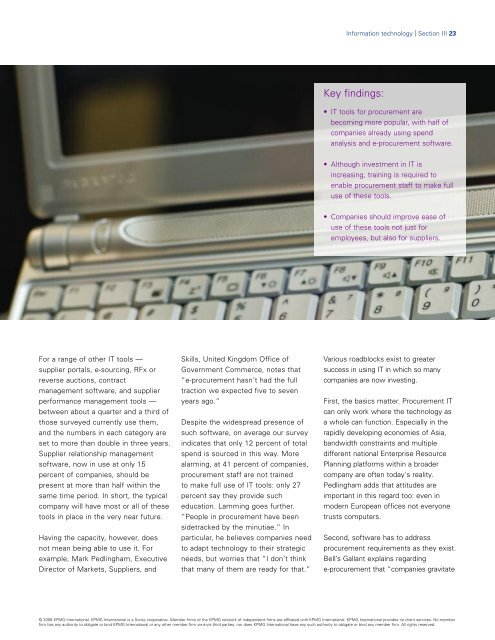Beyond purchasing
You also want an ePaper? Increase the reach of your titles
YUMPU automatically turns print PDFs into web optimized ePapers that Google loves.
Information technology | Section III 23<br />
Key findings:<br />
• IT tools for procurement are<br />
becoming more popular, with half of<br />
companies already using spend<br />
analysis and eprocurement software.<br />
• Although investment in IT is<br />
increasing, training is required to<br />
enable procurement staff to make full<br />
use of these tools.<br />
• Companies should improve ease of<br />
use of these tools not just for<br />
employees, but also for suppliers.<br />
For a range of other IT tools —<br />
supplier portals, esourcing, RFx or<br />
reverse auctions, contract<br />
management software, and supplier<br />
performance management tools —<br />
between about a quarter and a third of<br />
those surveyed currently use them,<br />
and the numbers in each category are<br />
set to more than double in three years.<br />
Supplier relationship management<br />
software, now in use at only 15<br />
percent of companies, should be<br />
present at more than half within the<br />
same time period. In short, the typical<br />
company will have most or all of these<br />
tools in place in the very near future.<br />
Having the capacity, however, does<br />
not mean being able to use it. For<br />
example, Mark Pedlingham, Executive<br />
Director of Markets, Suppliers, and<br />
Skills, United Kingdom Office of<br />
Government Commerce, notes that<br />
“eprocurement hasn’t had the full<br />
traction we expected five to seven<br />
years ago.”<br />
Despite the widespread presence of<br />
such software, on average our survey<br />
indicates that only 12 percent of total<br />
spend is sourced in this way. More<br />
alarming, at 41 percent of companies,<br />
procurement staff are not trained<br />
to make full use of IT tools: only 27<br />
percent say they provide such<br />
education. Lamming goes further.<br />
“People in procurement have been<br />
sidetracked by the minutiae.” In<br />
particular, he believes companies need<br />
to adapt technology to their strategic<br />
needs, but worries that “I don’t think<br />
that many of them are ready for that.”<br />
Various roadblocks exist to greater<br />
success in using IT in which so many<br />
companies are now investing.<br />
First, the basics matter. Procurement IT<br />
can only work where the technology as<br />
a whole can function. Especially in the<br />
rapidly developing economies of Asia,<br />
bandwidth constraints and multiple<br />
different national Enterprise Resource<br />
Planning platforms within a broader<br />
company are often today's reality.<br />
Pedlingham adds that attitudes are<br />
important in this regard too: even in<br />
modern European offices not everyone<br />
trusts computers.<br />
Second, software has to address<br />
procurement requirements as they exist.<br />
Bell’s Gallant explains regarding<br />
eprocurement that “companies gravitate<br />
© 2008 KPMG International. KPMG International is a Swiss cooperative. Member firms of the KPMG network of independent firms are affiliated with KPMG International. KPMG International provides no client services. No member<br />
firm has any authority to obligate or bind KPMG International or any other member firm visàvis third parties, nor does KPMG International have any such authority to obligate or bind any member firm. All rights reserved.



